The global jumbo bags market is projected to grow from USD 6.6 billion in 2025 to approximately USD 10 billion by 2035, recording an absolute increase of USD 10.6 billion over the forecast period. This translates into a total growth of 171.0%, with the market forecast to expand at a CAGR of 4.2% between 2025 and 2035. The overall market size is expected to grow by approximately 2.7X during the same period, supported by increasing demand for efficient bulk material handling, growing adoption across industrial sectors, and rising requirements for cost-effective packaging solutions across global logistics and manufacturing operations.
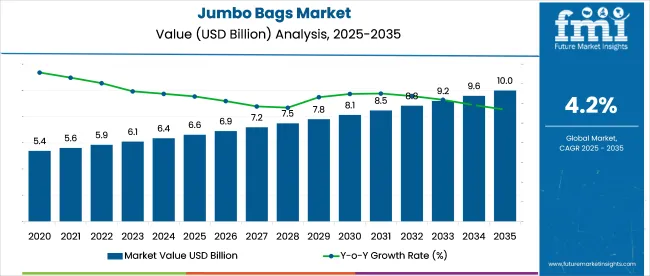
Between 2025 and 2030, the jumbo bags market is expected to grow from USD 6.6 billion to USD 10.3 billion, adding USD 4.1 billion, or 38.7% of the total decade growth. This expansion will be driven by rising demand for flexible intermediate bulk containers (FIBC), increasing adoption of bulk handling solutions, and the growing availability of specialized jumbo bags across industrial sectors. From 2030 to 2035, the market is projected to grow from USD 10.3 billion to USD 10 billion, adding USD 6.5 billion, or 61.3% of the overall growth. This phase will focus on the advancement of high-performance fabric technologies, innovative handling systems, and customized solutions tailored to diverse industrial needs. The growing emphasis on operational efficiency and optimized material handling will drive demand for jumbo bags with improved load capacity, discharge mechanisms, and enhanced durability. Innovations in fabric engineering and structural design will be key drivers in this market’s continued expansion.
| Metric | Value |
|---|---|
| Estimated Value in (2025E) | USD 6.6 billion |
| Forecast Value in (2035F) | USD 10 billion |
| Forecast CAGR (2025 to 2035) | 4.2% |
The packaging industry is the largest contributor, accounting for approximately 40-45%. Jumbo bags, or FIBCs, are highly favored in this sector due to their ability to carry large quantities of various materials like chemicals, agricultural products, and construction supplies. Their large capacity, durability, and ease of handling make them ideal for industries involved in the transportation of bulk goods, offering an efficient solution to reduce handling costs. The agriculture market, contributing around 20-25%, also plays a significant role, where jumbo bags are used extensively to package grains, seeds, fertilizers, and other agricultural products. Their ability to protect the contents from moisture, dirt, and pests while offering a convenient means of storage and transport further drives their demand in the agricultural sector.
The chemical industry, contributing about 15-20%, relies on jumbo bags for transporting a wide range of chemicals, including granular substances, powders, and liquids. These bags offer strength and resilience, capable of withstanding harsh conditions, making them ideal for chemical transportation. The construction market, holding around 10-12%, uses jumbo bags to transport heavy materials like sand, cement, gravel, and aggregates, where their large capacity and ease of use on construction sites are essential. The food and beverage market, with a share of about 5-8%, uses jumbo bags for bulk packaging of ingredients like flour, sugar, and grains. These parent markets underscore the growing demand for jumbo bags across diverse industries, driven by their cost-effectiveness, capacity, and durability in transporting bulk goods.
Market expansion is being supported by the increasing global demand for bulk material handling solutions and the corresponding shift toward industrial-grade packaging that can provide superior capacity outcomes while meeting user requirements for safety assurance and efficient logistics processes. Modern manufacturers are increasingly focused on incorporating flexible packaging solutions that can enhance operational efficiency while satisfying demands for durable, consistently performing containers and optimized material handling practices. Jumbo bags' proven ability to deliver capacity benefits, material safety, and diverse application possibilities makes them essential products for bulk-handling professionals and efficiency-conscious organizations.
The growing emphasis on logistics optimization and operational excellence is driving demand for high-quality jumbo bags that can support distinctive capacity outcomes and comprehensive safety positioning across chemical transport, agricultural storage, and construction material categories. User preference for products that combine handling efficiency with cost-effectiveness is creating opportunities for innovative implementations in both traditional and emerging industrial applications. The rising influence of industrial standards and material handling initiatives is also contributing to increased adoption of jumbo bags that can provide authentic safety benefits and reliability characteristics.
The market is segmented by product type, material type, end-use industry, and region. By product type, the market is divided into Type A FIBC, Type B FIBC, Type C FIBC, Type D FIBC, form-stable bags, baffle bags, and other jumbo bags. Based on material type, the market is categorized into polypropylene, polyethylene, and other materials. By end-use industry, the market includes construction, chemicals & fertilizers, food & beverages, agriculture, mining, and other industries. Regionally, the market is divided into North America, Europe, Asia Pacific, Latin America, Middle East & Africa, and other regions.
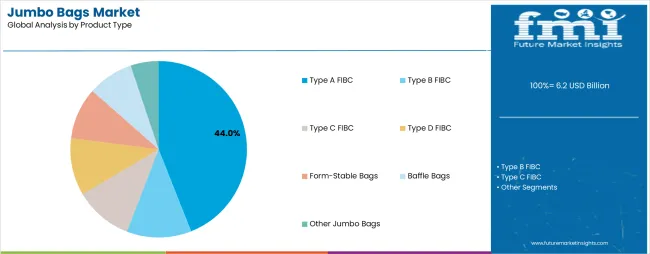
The Type A FIBC segment is projected to account for 44% of the jumbo bags market in 2025, reaffirming its position as the leading product category. Manufacturers and industrial operators increasingly utilize Type A FIBC for their cost-effective characteristics, established load-bearing capacity, and essential functionality in bulk material handling applications across diverse industrial categories. Type A FIBC's standardized structural characteristics and proven handling effectiveness directly address user requirements for reliable material containment and optimal capacity value in industrial applications.
This product segment forms the foundation of modern bulk packaging patterns, as it represents the format with the greatest industrial acceptance potential and established compatibility across multiple material handling systems. Industrial investments in logistics optimization and efficiency standardization continue to strengthen adoption among cost-conscious organizations. With users prioritizing material containment and handling reliability, Type A FIBC aligns with both operational objectives and performance requirements, making them the central component of comprehensive bulk material handling strategies.
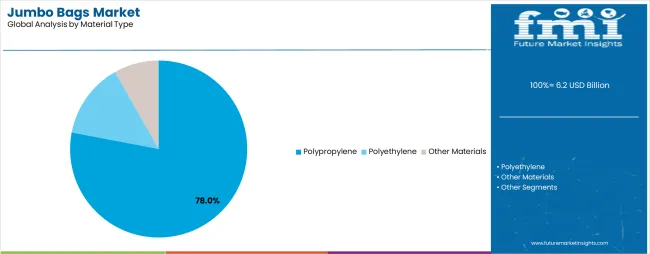
Polypropylene is projected to represent 78% of the jumbo bags market growth through 2035, underscoring its critical role as the primary choice for quality-focused manufacturers seeking superior strength benefits and enhanced durability credentials. Industrial users and bulk material handlers prefer polypropylene bags for their enhanced tensile standards, proven lightweight superiority, and ability to maintain exceptional load-bearing profiles while supporting long-term usage during high-volume handling experiences. Positioned as essential products for demanding industrial applications, polypropylene offerings provide both strength excellence and durability advantages.
The segment is supported by continuous improvement in polypropylene fabric technology and the widespread availability of established manufacturing infrastructure that enables quality assurance and competitive positioning at the industrial level. Additionally, bag manufacturers are optimizing polypropylene processing methods to support market differentiation and accessible pricing. As materials technology continues to advance and users seek superior handling solutions, polypropylene bags will continue to drive market growth while supporting operational efficiency and industrial handling strategies.
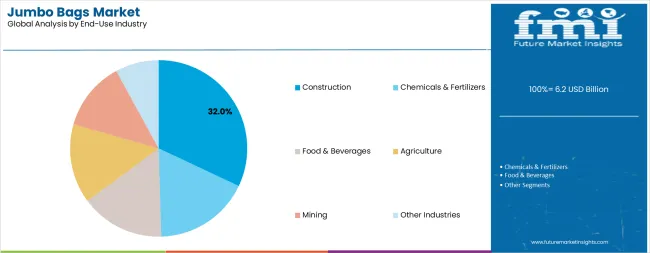
The construction segment is projected to account for 32% of the jumbo bags market in 2025, driven by increasing demand for bulk handling of building materials, aggregates, and construction supplies. Construction professionals prefer jumbo bags for their superior load capacity, efficient material transport, and ability to handle various construction materials including sand, gravel, cement, and demolition waste. The segment's dominance reflects the construction industry's continuous need for cost-effective, high-capacity packaging solutions that can withstand rigorous handling conditions while maintaining material integrity.
This end-use category represents the largest application area for jumbo bags, as construction projects worldwide require reliable bulk packaging for multiple material types. The growing infrastructure development across emerging economies and ongoing construction activities in developed markets continue to strengthen demand for specialized construction-grade FIBC products. With the construction industry prioritizing operational efficiency and material handling optimization, jumbo bags have become indispensable tools for modern building operations and large-scale construction projects.
The jumbo bags market is advancing rapidly due to increasing bulk material handling consciousness and growing need for industrial-grade packaging choices that emphasize superior capacity outcomes across manufacturing segments and logistics applications. The market faces challenges, including storage space requirements, transportation considerations for empty bags, and supply chain complexities affecting pricing stability. Innovation in fabric materials and specialized product development continues to influence market development and expansion patterns.
The growing adoption of jumbo bags in specialized industrial programs and material-intensive applications is enabling users to develop handling patterns that provide distinctive capacity benefits while commanding operational positioning and enhanced efficiency characteristics. Industrial applications provide superior load density while allowing more sophisticated material handling across various manufacturing categories. Users are increasingly recognizing the competitive advantages of jumbo bag positioning for bulk material handling and efficiency-conscious operational integration.
Modern jumbo bag manufacturers are incorporating advanced engineering systems, customization technologies, and quality management protocols to enhance load-bearing capabilities, improve user outcomes, and meet industrial demands for material-specific handling solutions. These systems improve bag effectiveness while enabling new applications, including discharge optimization and specialized configuration programs. Advanced customization integration also allows manufacturers to support competitive market positioning and capacity leadership beyond traditional packaging operations.
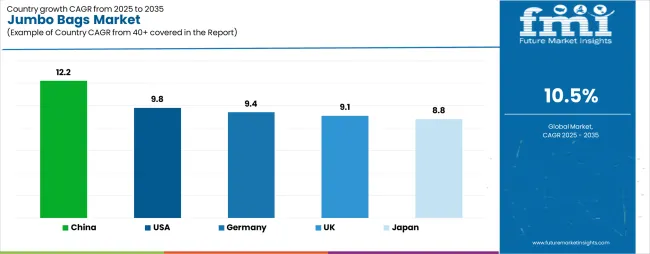
| Country | CAGR (2025-2035) |
|---|---|
| USA | 9.8% |
| Germany | 9.4% |
| UK | 9.1% |
| China | 12.2% |
| Japan | 8.8% |
The jumbo bags market is experiencing robust growth globally, with China leading at a 12.2% CAGR through 2035, driven by the expanding manufacturing sector, growing industrial capacity, and increasing adoption of bulk packaging solutions. The USA follows at 9.8%, supported by rising industrial activity, expanding construction infrastructure, and growing acceptance of efficient material handling solutions. Germany shows growth at 9.4%, emphasizing established industrial markets and comprehensive manufacturing development. The UK records 9.1%, focusing on construction expansion and industrial material handling. Japan demonstrates 8.8% growth, prioritizing quality packaging solutions and technological advancement.
The report covers an in-depth analysis of 40+ countries, with the top-performing countries highlighted below.
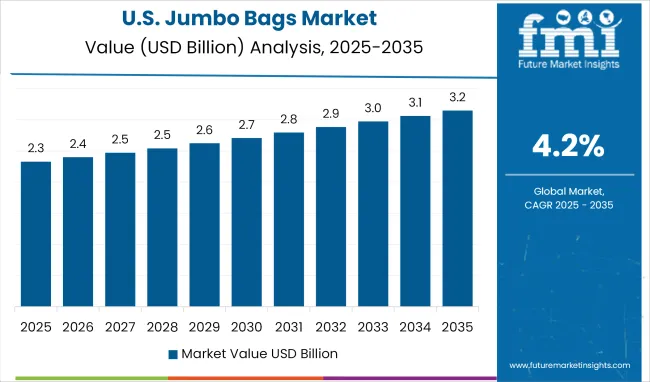
Revenue from jumbo bags consumption and sales in the USA is projected to exhibit exceptional growth with a CAGR of 9.8% through 2035, driven by the country's rapidly expanding construction sector, favorable industrial attitudes toward bulk packaging, and initiatives promoting logistics optimization across major manufacturing regions. The USA's position as a leading industrial market and increasing focus on material handling development are creating substantial demand for high-quality jumbo bags in both commercial and industrial markets. Major packaging suppliers and specialty FIBC providers are establishing comprehensive distribution capabilities to serve growing industrial demand and emerging handling opportunities.
Demand for jumbo bags in Germany is expanding at a CAGR of 9.4%, supported by rising manufacturing sophistication, growing industrial precision, and expanding bulk handling infrastructure. The country's developing industrial capabilities and increasing investment in efficient logistics are driving demand for jumbo bags across both imported and domestically produced applications. International packaging companies and domestic manufacturers are establishing comprehensive distribution networks to address growing market demand for quality FIBC and bulk packaging solutions.
Revenue from jumbo bags products in the UK is projected to grow at a CAGR of 9.1% through 2035, supported by the country's mature construction market, established industrial culture, and leadership in quality standards. Britain's sophisticated logistics infrastructure and strong support for operational efficiency are creating steady demand for both traditional and innovative jumbo bag varieties. Leading packaging suppliers and specialty FIBC providers are establishing comprehensive operational strategies to serve both domestic markets and growing export opportunities.
The sale of jumbo bags in China is forecasted to expand at a CAGR of 12.2% through 2035, driven by the country's emphasis on industrial expansion, manufacturing leadership, and sophisticated production capabilities for materials requiring specialized bulk packaging varieties. Chinese manufacturers and distributors consistently seek industrial-grade products that enhance material handling and support manufacturing operations for both traditional and innovative industrial applications. The country's position as an Asian manufacturing leader continues to drive innovation in specialty FIBC applications and industrial product standards.
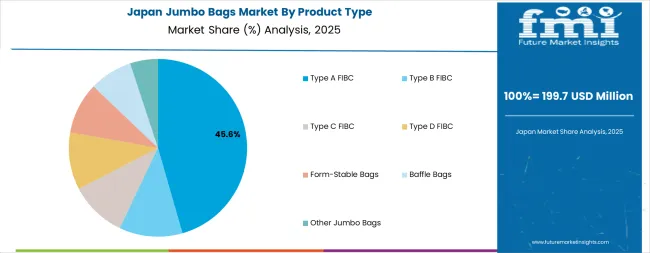
Revenue from jumbo bags products in Japan is projected to expand at a CAGR of 8.8% through 2035, supported by the country's emphasis on quality manufacturing, industrial standards, and advanced logistics integration requiring efficient bulk packaging solutions. Japanese manufacturers and material handlers prioritize quality performance and precision handling, making jumbo bags essential components for both traditional and modern industrial applications. The country's comprehensive manufacturing excellence and advancing industrial patterns support continued market expansion.
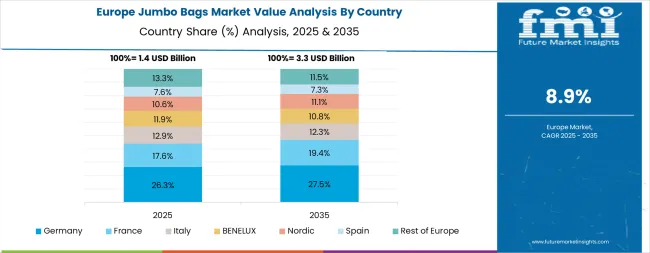
The Europe jumbo bags market is projected to grow from USD 2.1 billion in 2025 to USD 4.8 billion by 2035, recording a CAGR of 8.6% over the forecast period. Germany leads the region with a 33.0% share in 2025, moderating slightly to 32.5% by 2035, supported by its strong manufacturing culture and demand for quality, industrially engineered FIBC products. The United Kingdom follows with 22.0% in 2025, easing to 21.5% by 2035, driven by a sophisticated construction market and emphasis on operational efficiency. France accounts for 19.0% in 2025, rising to 19.5% by 2035, reflecting steady adoption of bulk packaging solutions and industrial consciousness. Italy holds 12.0% in 2025, expanding to 12.8% by 2035 as industrial modernization and construction applications grow. Spain contributes 8.0% in 2025, growing to 8.5% by 2035, supported by expanding manufacturing and agricultural handling. The Nordic countries rise from 4.0% in 2025 to 4.5% by 2035 on the back of strong quality adoption and advanced industrial integration. BENELUX remains at 2.0% share across both 2025 and 2035, reflecting mature, efficiency-focused markets.
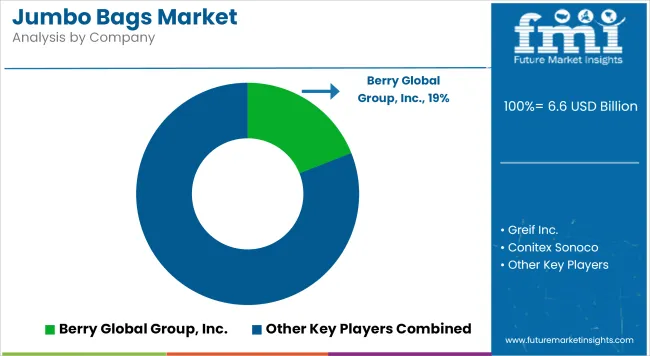
The jumbo bags market is characterized by competition among established flexible packaging companies, specialized FIBC manufacturers, and integrated bulk handling solution providers. Companies are investing in fabric technologies, advanced manufacturing systems, product innovation capabilities, and comprehensive distribution networks to deliver consistent, high-quality, and durable jumbo bags. Innovation in load enhancement, efficient production methods, and application-specific product development is central to strengthening market position and customer satisfaction.
Berry Global Inc. leads the market with a strong focus on flexible packaging innovation and comprehensive FIBC solutions, offering premium jumbo bags with emphasis on capacity excellence and manufacturing heritage. LC Packaging International BV provides specialized bag manufacturing capabilities with a focus on European market applications and custom design networks. Greif Inc. delivers integrated bulk packaging solutions with a focus on quality positioning and operational efficiency. BAG Corp specializes in comprehensive FIBC manufacturing with an emphasis on industrial applications. AmeriGlobe LLC focuses on comprehensive material handling solutions with advanced engineering and competitive positioning capabilities.
The success of jumbo bags in meeting industrial handling demands, material-driven capacity requirements, and quality assurance integration will not only enhance operational outcomes but also strengthen global manufacturing capabilities. It will consolidate emerging regions' positions as hubs for efficient FIBC manufacturing and align advanced economies with industrial material handling systems. This calls for a concerted effort by all stakeholders - governments, industry bodies, suppliers, distributors, and investors. Each can be a crucial enabler in preparing the market for its next phase of growth.
How Governments Could Spur Local Production and Adoption?
How Industry Bodies Could Support Market Development?
How Distributors and Industrial Material Players Could Strengthen the Ecosystem?
How Suppliers Could Navigate the Shift?
| Items | Values |
|---|---|
| Quantitative Units (2025) | USD 6.6 billion |
| Product Type | Type A FIBC, Type B FIBC, Type C FIBC, Type D FIBC, Form-Stable Bags, Baffle Bags, Other Jumbo Bags |
| Material Type | Polypropylene, Polyethylene, Other Materials |
| End-Use Industry | Construction, Chemicals & Fertilizers, Food & Beverages, Agriculture, Mining, Other Industries |
| Regions Covered | North America, Europe, Asia Pacific, Latin America, Middle East & Africa, Other Regions |
| Countries Covered | United States, Germany, United Kingdom, China, Japan, and 40+ countries |
| Key Companies Profiled | Berry Global Inc., LC Packaging International BV, Greif Inc., BAG Corp, AmeriGlobe LLC, and other leading jumbo bag companies |
| Additional Attributes | Dollar sales by product type, material type, end-use industry, and region; regional demand trends, competitive landscape, technological advancements in fabric engineering, handling system integration initiatives, quality enhancement programs, and customized product development strategies |
The global jumbo bags market is estimated to be valued at USD 6.6 billion in 2025.
The market size for the jumbo bags market is projected to reach USD 10 billion by 2035.
The jumbo bags market is expected to grow at a 4.2% CAGR between 2025 and 2035.
The key product types in jumbo bags market are type a fibc, type b fibc, type c fibc, type d fibc, form-stable bags, baffle bags and other jumbo bags.
In terms of material type, polypropylene segment to command 78.0% share in the jumbo bags market in 2025.






Full Research Suite comprises of:
Market outlook & trends analysis
Interviews & case studies
Strategic recommendations
Vendor profiles & capabilities analysis
5-year forecasts
8 regions and 60+ country-level data splits
Market segment data splits
12 months of continuous data updates
DELIVERED AS:
PDF EXCEL ONLINE
Market Share Analysis of Jumbo Bags & Key Players
PE Jumbo Bags Market Size and Share Forecast Outlook 2025 to 2035
Jumbo Kraft Tubes Market
PP Jumbo Bag Market Size and Share Forecast Outlook 2025 to 2035
Polybags Market Size and Share Forecast Outlook 2025 to 2035
Net Bags Market
VCI Bags Market
Sandbags Market
Leno Bags Market Size and Share Forecast Outlook 2025 to 2035
Silo bags Market Size and Share Forecast Outlook 2025 to 2035
Food Bags Market Share, Size, and Trend Analysis for 2025 to 2035
Competitive Breakdown of Silo Bag Manufacturers
Paper Bags Market Size and Share Forecast Outlook 2025 to 2035
Blood Bags Market Size and Share Forecast Outlook 2025 to 2035
Craft Bags Market Growth, Trends, Forecast 2025 to 2035
Market Share Breakdown of Craft Bags Manufacturers
Competitive Breakdown of Paper Bags Providers
Grout Bags Market Demand & Construction Industry Trends 2024 to 2034
Sugar Bags Market
Cotton Bags Market Size and Share Forecast Outlook 2025 to 2035

Thank you!
You will receive an email from our Business Development Manager. Please be sure to check your SPAM/JUNK folder too.
Chat With
MaRIA